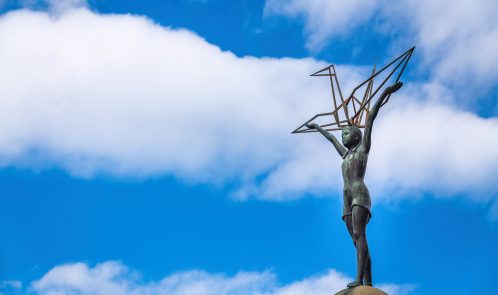
Hiroshima, Japan – Children’s Peace Monument – this monument for peace to commemorate Sadako Sasaki and the children victims of the atomic bombing.
Sadako was born in 1943 in Hiroshima Japan during World War Two. At the time her parents owned a barbershop, and they lived an ordinary life, but their normal life would soon end. Her life changed when her father got drafted to fight with the Japanese army. Then, her life changed again when the atomic bomb was dropped on Hiroshima. Years later, the radiation from the atomic bomb was still in Hiroshima. Sadako was diagnosed with leukemia, but she came up with an idea she thought would help cure her. She planned to fold one thousand paper cranes, and in doing this Sadako inspired people never to give up. It all started when Sadako was two years old, and the atomic bomb was dropped on Hiroshima.
On the morning of August 6, 1945, Sadako’s brother Masahiro said that everything seemed normal. He said that he did not hear any air raid siren or the bomb going off. He was going to sit down on his mat to eat when suddenly he was pushed under the table with the mats on top of him. After he had managed to get out from under the mats, his mother started looking to see if everyone was still in the house.
They found out that Sadako had been thrown out of the window. Her mother ran outside to look for her thinking that she was dead, and was surprised to find her uninjured. Sadly, on the way back to the house they found it burnt to the ground, so they ran to the Misasa Bridge for refuge but on the way to the bridge they were caught in the Black Rain.
A couple of years after the dropping of the atomic bomb, Sadako’s life became normal again. She became an athlete and was the fastest runner in her school. But a few years after that, she discovered lumps had formed on her neck and behind her ears. Sadako had been diagnosed with leukemia. After a few days in the hospital, Sadako’s father told her a Japanese legend that said whoever folded 1,000 paper cranes would be granted a wish and Sadako began folding paper cranes. But sadly, in her lifetime, Sadako only managed to fold 644 paper cranes. She died at the age of 12 in 1955.
When she died, her friends made the remaining 356 paper cranes that Sadako could not make so that her dying wish would be complete. Her classmates finished folding the rest of the paper cranes. The story of their kindness made it in the news and they became known in Japan then all over the world. Her classmates raised money to build a statue in remembrance of Sadako. At the bottom of the statue, it has a plaque that says “This is our cry, This is our prayer, peace in the world.” Sadako’s folding of the paper cranes inspired people never to give up. Because of all the things that happened, Sadako made the paper crane a symbol of peace.
Recourses:
http://www.pcf.city.hiroshima.jp/virtual/VirtualMuseum_e/exhibit_e/exh0107_e/exh01071_e.html
Rose, Michael, The Girl who Transformed the Paper Crane Into the Symbol for Peace and Symbol, The
World Post, Bergruen Institute, Huffington Post reprint https://www.huffingtonpost.com/michael-rose/the-girl-who- transformed-the- paper-crane_b_3787670.html